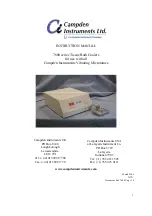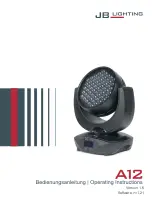
OPERATOR’S
MANUAL
VER2.0C201
FingertipPulse Oximeter
General Description
Oxygen Saturation is a percentage of Oxyhemoglobin (HbO
2
) capacity, compounded with
oxygen, by all combinative hemoglobin (Hb) capacity in blood. In other words, it is
consistency of Oxyhemoglobin in blood. It is a very important parameter for the Respiratory
circulation System. Many respiratory diseases can result in oxygen saturation being lowered
in human blood. Additionally, the following factors can reduce oxygen saturation: Automatic
regulation of organ dysfunction caused by Anesthesia, Intensive Postoperative Trauma,
injuries caused by some medical examinations. That situation might result in
light-headedness, asthenia, and vomiting. Therefore, it is very important to know the oxygen
saturation of a patient so that doctors can find problems in a timely manner.
The fingertip pulse Oximeter features small size, low power consumption, convenient
operation and portability. It is only necessary for a patient to put one of his fingers into the
fingertip photoelectric sensor for diagnosis, and a display screen will show oxygen saturation.
It has been proven in clinical experiments that it also features high precision and repeatability.
Measurement principle
Principle of the Oximeter is as follows: A mathematical formula is established making use of
Lambert Beer Law according to Spectrum Absorption Characteristics of Reductive
hemoglobin(RHb) and Oxyhemoglobin (HbO
2
) in glow and near-infrared zones. Operation
principle of the instrument is Photoelectric Oxyhemoglobin Inspection Technology is adopted
in accordance with Capacity Pulse Scanning and Recording Technology, so that two beams
of different wavelength of lights (660nm glow and 940nm near infrared light) can be focused
onto a human nail tip through a clamping finger-type sensor. A measured signal obtained by a
photosensitive element, will be shown on two groups of LEDs through process in electronic
circuits and microprocessor
shown on two groups of LEDs through electronic circuits and a
microprocessor.
Diagram of Operation Principle
1. Red and Infrared-ray Emission Tube
2. Red and Infrared-ray Receipt Tube
Precautions for use
1
Do not use the pulse Oximeter in an MRI or CT environment.
2
Do not use the pulse Oximeter in situations where alarms are required. The device has
no alarms.
3
Explosion hazard: Do not use the pulse Oximeter in an explosive atmosphere.
4
The pulse Oximeter is intended only as an adjunct in patient assessment. It must be
used in conjunction with other methods of assessing clinical signs and symptoms.
5
Check the pulse Oximeter sensor application site
frequently
to determine the positioning
of the sensor, circulation, and skin sensitivity.
6
Do not stretch the adhesive tape while applying the pulse Oximeter sensor. This may
cause inaccurate readings or skin blisters.
7
Before use, carefully read the manual.
8
The pulse Oximeter has no SpO
2
alarms; it is not for continuous monitoring, as indicated
by the symbol.
9
Prolonged use or the patient’s condition may require changing the sensor site
periodically. Change sensor site and check skin integrity, circulatory status, and correct
alignment at least every 4 hours.
10 Inaccurate measurements may be caused by autoclaving, ethylene oxide sterilizing, or
immersing the sensors in liquid.
11 Significant levels of dysfunctional hemoglobins (such as carboxyhemoglobin or
methemoglobin) may cause inaccurate readings.
12
Intravascular dyes such as indocyanine green or methylene blue may cause inaccurate
readings.
13 SpO
2
measurements may be adversely affected in the presence of bright light. Shield
the sensor area (with a towel, from direct sunlight, for example) if necessary.
14
Excessive patient movement may cause inaccurate readings.
15
High-frequency electrosurgical interference.
16
Venous pulsations may cause inaccurate readings.
17 Placement of a sensor on an extremity with a blood pressure cuff, arterial catheter, or
intravascular line may cause inaccurate readings.
18 Hypotension, severe vasoconstriction, severe anemia, or hypothermia may cause
inaccurate readings.
19
Cardiac arrest or shock may cause inaccurate readings.
20
Fingernail polish or false fingernails may cause inaccurate SpO
2
readings.
Follow local ordinances and recycling instructions regarding disposal or recycling of
the device and device components, including batteries.
Product Properties
1
Operation of the product is simple and convenient.
2
The product is small in size, light in weight (total weight is about 50g including batteries).
3
Power consumption of the product is low and the two originally-equipped, two AAA
batteries can be operated continuously for 30 hours.
4
A low voltage warning will be shown on the display when battery voltage is so low that
the Oximeter might not operate normally.
5
The product will automatically be powered off when no signal is detected for longer than
8 seconds.
Product Operation Scope
The fingertip Oximeter can be used to measure human Oxygen Saturation and heart rate
through the finger. The product is suitable for use in families, hospitals (including clinical use
in internist/surgery, anesthesia, pediatrics, intensive care etc.) Oxygen Clubs, social medical
organizations, and in sports (It can be used before or after sports. Operation during sports is
not recommended.).
The product is not suitable to monitor a patient continuously.
Operation Instructions
1
Install two AAA batteries into battery cassette before closing its cover.
Insert a finger into the rubber hole of the Oximeter, as shown in the diagram below. (It is
best to insert the finger as far as possible before releasing the clamp.)
2
Press the switch button once on front panel.
3
While using the Oximeter, your finger should not tremble and you should not move
around.
4
Read corresponding data on the display screen.
5
Two display modes.
After turning on the Oximeter, each time you press the power switch the Oximeter will
switch to another display mode. There are two display modes, shown as follows:
1
2
When you press the power switch for a long time (more than one second), the brightness of
the Oximeter will be changed by degrees, there are 10 levels on brightness; the default level
is level four.
Note: Please use medical alcohol to clean the rubber, inside the Oximeter, that touches the
finger. Also, clean the test finger with alcohol before and after each test. (The rubber inside of
the Oximeter is medical rubber, which has no toxins, and is not harmful to the skin).
When your finger is inserted into the Oximeter, your nail surface must be upward.
Brief Description of Front Panel
The pulse rate bar graph display corresponds with pulse rate.
Product Accessories
1.
One hang lace
2. Two
batteries
3.
One user manual
SPO
2
PR
Power
Swith
PR bar graph
Pulse One




















